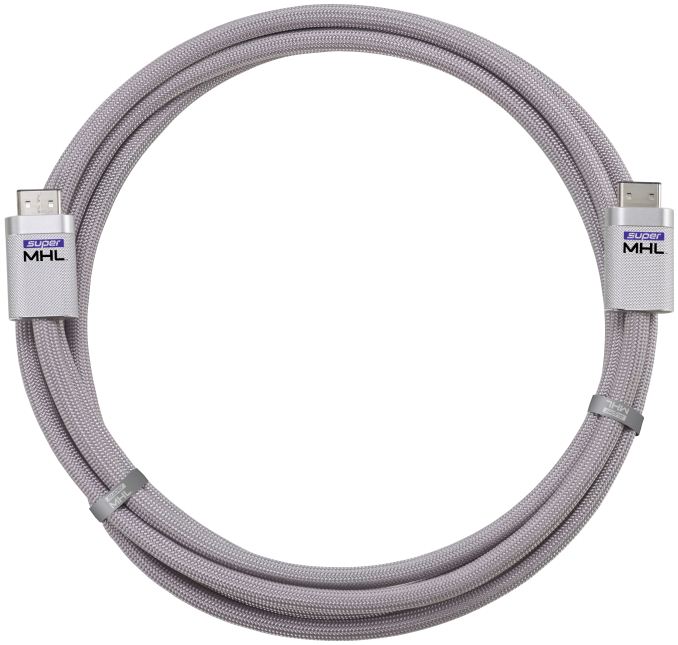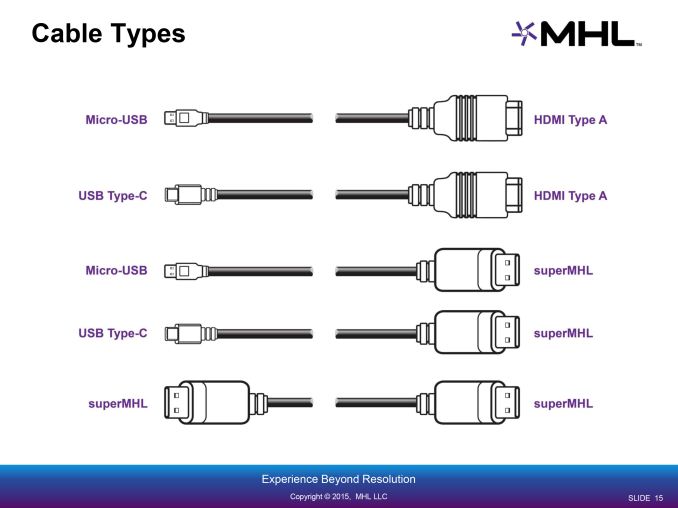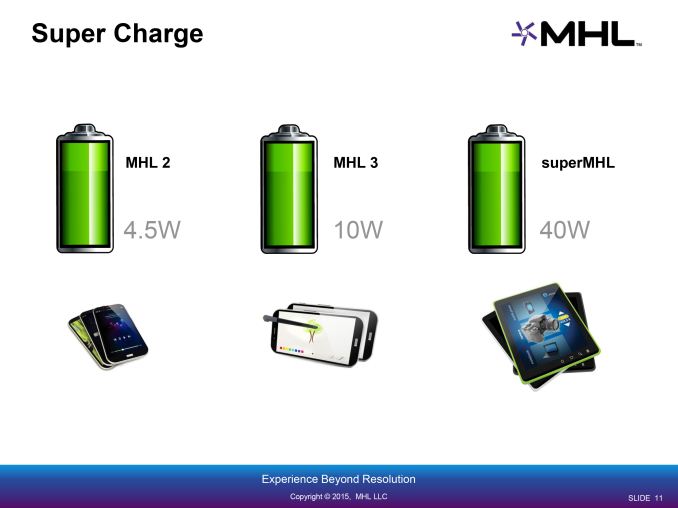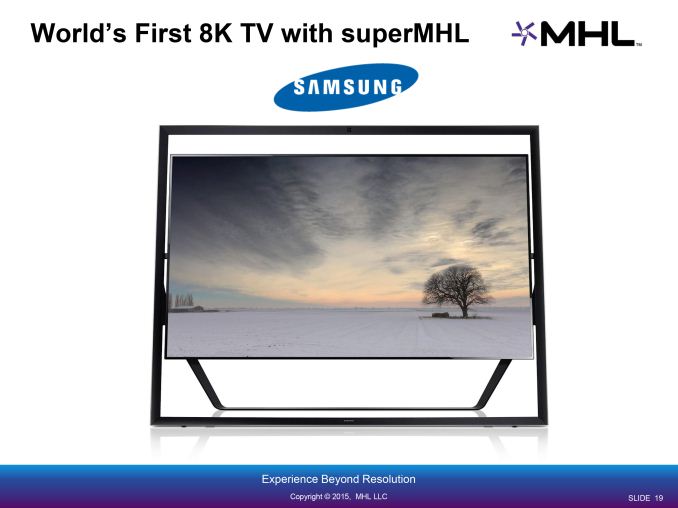MHL Consortium Announces superMHL: New Standard & New Cable To Drive 8K TV
by Ryan Smith on January 6, 2015 1:00 PM EST
When the Mobile High-Definition Link (MHL) was introduced in 2010, it was created to solve a simple but none the less daunting problem: how to get power in and digital video out of cell phones and other mobile devices without requiring additional (or more complex) ports, such as what would be required for HDMI. The solution developed by Silicon Image and the MHL Consortium members was the ultimate piggy-back solution, devising a method to handle power and video using just 5 pins (the number of pins in a mini/micro-USB 2.0 connector) and connecting it to MHL-compliant TVs via their HDMI ports. MHL had no port or cable to call its own, but it had an altered protocol based on the same TMDS technology behind HDMI that made it possible to get video off of mobile devices.
Flash forward a few years, and while there have been successive versions of MHL – the most recent being MHL 3 – all of these have built on the original design principles of MHL, focusing on the Mobile part of Mobile High-Definition Link while improving the specification. For this reason it came as quite a surprise to us this week when we found out that the MHL consortium was planning on taking MHL beyond its mobile roots and moving into the TV space, greatly extending the features and use cases in the process. With a mandate to provide a cable for 8K video at up to 120fps, MHL is no longer aiming low; with today’s announcement of superMHL, MHL is now aiming for nothing less than the top.
superMHL in a nutshell is a pair of improvements to the MHL specification to further improve mobile connectivity and to enable 8K video. First and foremost, the protocol itself is being improved: superMHL doubles the amount of bandwidth available over a single lane to allow for 4Kp60 video, along with defining support for deep color modes (10/12/16bit) and newer color spaces. This alone would be a notable improvement to MHL, especially as H.265 capable phones being to hit the market and the H.265 backers are pushing 4Kp60 video and 10-bit color themselves, necessitating a video interface capable of delivering that data.
| MHL Specification Comparison | |||||
| superMHL (6 Lanes) | superMHL (1 Lane) | MHL 3 (1 Lane) | |||
| Maximum Resoluion | 8Kp120, 4:2:0 36-bit color | 4Kp60 | 4Kp30 | ||
| Deep Color Support | Yes | Yes | No | ||
| Power Charging | 40W | Up To 40W, Depending On Cable | 10W | ||
| Requires superMHL Cable | Yes | No | No | ||
However the more dramatic change is in the second improvement coming to superMHL, which is the introduction of the superMHL cable and connector. This unusual development was spurred on by the television manufacturing members of the MHL Consortium, who in developing their future 8K (7680x4320) televisions wanted a single cable that could carry the enormous amount of data required for 8K video with deep color and high frame rates. Compounding matters, the usual TV connector of choice, HDMI, was not going to be ready for the job, as HDMI 2.0 was only planned for up to 4Kp60 video. Consequently TV manufacturers turned to the MHL Consortium, who became tasked with developing a cable and connector standard for 8K video.
The Consortium’s solution was the suitably named superMHL connector. A reversible connector containing 32 pins, the superMHL is among the densest digital video connectors ever devised, packing those 32 pins in a space roughly the same size as the 19 pin HDMI Type-A cable. With 32 pins the superMHL connector would be capable of carrying 6 lanes of MHL data as opposed to 1 lane on a traditional MHL setup, providing the necessary bandwidth for 8K video, and capable of carrying it two to three meters over a standard (passive) cable.
By going this route the MHL standard now serves two masters, mobile and the home, and consequently the standard now covers a much wider range of use cases and potential configurations. superMHL-to-superMHL cables will be the cable necessary for 8K video, and meanwhile USB to HDMI cables will continue to support mobile devices.
Overall the superMHL standard allows for ether the traditional HDMI connector or the new superMHL connector as a “sink” connector, and no fewer than 3 “source” connectors. Joining the regular micro-USB as a source, USB type-C and the superMHL connector are now supported as source connectors as well. Of these combinations we expect superMHL to superMHL and USB to HDMI will be the most common, especially since 4K TVs can still go ahead and implement superMHL protocol support for 4Kp60 video without using a superMHL port. However if superMHL ports on TVs gain traction, then direct USB to superMHL would become increasingly viable. Meanwhile for USB Type-C in particular, thanks to the Type-C’s alternate mode support, Type-C to superMHL will be able to support 2 or 4 MHL data lanes (versus 1 for micro-USB), leaving the door open to potential mid-bandwidth use cases in the future.
Finally, along with the changes to the MHL protocol and physical interface, for superMHL the standard is also having its power and multi-display limits increased. superMHL power delivery will allow for up to 40W (20V @ 2A) versus MHL 3’s 10W, which will allow MHL connections to carry enough power to not just run tablets but to charge them as well. Meanwhile, though currently rarely used in any form, superMHL increases the number of displays allowed in an MHL multi-display configuration to 8 displays, thanks in large part to the bandwidth increases.
Ultimately today’s announcement from the MHL Consortium marks an interesting turn of events in what has otherwise been a complementary relationship between MHL and HDMI. Though this doesn’t make the standards competing standards – especially not when both are based on TMDS technology and both have TMDS owner Silicon Image among their members – this does for the first time create a real degree of overlap between the two. MHL’s place in mobile is as secure as it ever was, but what will come of their home/TV efforts remains to be seen.
At least in the short term superMHL will be the only option for 8K TV, and in fact Samsung already has an 8K TV with superMHL up and running for CES. But how long it superMHL remains the only option for 8K is another matter entirely. Even outside of its higher bandwidth support, superMHL has some other technological advantages such as the reversible connector and the ability to carry power which give it an advantage over HDMI for 4K video, but for most cases this is not going to be a massive advantage.
In any case, ignoring the HDMI overlap for the time being, superMHL should still bring tangible benefits for both of its primary markets. With an upgraded protocol capable of supporting 4Kp60, MHL is better than ever for traditional mobile applications. Meanwhile with the new superMHL cable and connector, TV manufacturers eager to get 8K TVs out the door will finally have a single cable standard to drive those TVs with.
















68 Comments
View All Comments
stephenbrooks - Tuesday, January 6, 2015 - link
Not to mention VGA inputs on data projectors (although I'm starting to find some with HDMI now). Full-size DP made an unwelcome appearance on a Dell laptop I got given, had to buy a special cable to turn it into HDMI.CharonPDX - Tuesday, January 6, 2015 - link
VGA on motherboards is due to the continued corporate need for "backward compatible" systems - which tend to be as cheap as possible.As someone else mentioned, many older (yet very expensive when bought, so unlikely to be replaced soon,) projectors are VGA-only. Plus some of the more insane low-end LCD desktop monitors that only have VGA. (Or VGA+one other, so if you want to share between systems, you have to use VGA for one.)
VGA needs to die. DVI needs to die. full-size DisplayPort needs to die. All "computers" should use miniDP, all "home theater" devices should use HDMI. Mobile computing devices can use USB type C with an HDMI/MHL adapter. (MHL really should continue to just be a "rides along on existing connectors" standard, not a separate plug!)
Likewise, USB type C should take over as the "non-display/not ultra-high-speed" connector of choice for all computing devices. A new high-end laptop should have two Thunderbolt (aka mini DisplayPort physically) ports, and 2-4 USB type C ports. And that's it. (And Thunderbolt should add charging without changing the connector.) Charging over any port, outbound power delivery over any port. (Run that mobile monitor directly from the laptop; charge the laptop from the single cable from the monitor, etc.)
danbob999 - Tuesday, January 6, 2015 - link
why should PC and TVs have different types of connectors?stephenbrooks - Tuesday, January 6, 2015 - link
Glue a fibre optic cable to a mains cord. The ultimate cable for maximum power and data.doubledeej - Tuesday, January 6, 2015 - link
They need to fix digital connections first. They still don't work right.My 27" Dell monitor (2560x1440) is 100% reliable with VGA. With DisplayPort it loses connection to the computer frequently. DVI is a little better, but it still isn't what I would call great. Yes, the image is slightly better with the digital connections compared to analog, but what good is it if it can't be trusted?
My 28" Dell 4K monitor only works on a couple of my computers. Neither the DisplayPort nor HDMI connection works consistently with any computer I connect it to.
On my Macs, it only works at 1080p, with both DP and HDMI. I've never gotten it to run at its full resolution; it isn't even a selectable option. That same monitor on my newest Dell laptop, HDMI will display the full 4K resolution for a couple of minutes, but then it cuts out completely and has to be reconnected to come back. And while it is actually displaying an image it has random flashing pixels all over the place. On another (nearly 5-year old laptop) the same monitor mostly works with DisplayPort, but it will eventually lose connection with that one as well after an hour or so. The same monitor will occasionally show an image when connected to my GeForce 760 card (via DisplayPort; HDMI only operates at 1080p on that one), but then it loses connection and the only way to fix it is to reboot the computer. I'm pretty confident that VGA wouldn't have any of those problems, just because it is super simple.
None of it is cable related; I've tried many different cables, all with identical results.
HDMI, DisplayPort, and even DVI might work okay under "normal" conditions (say, 1080p60), but they seriously break down when pushed, even within their designed specs. VGA was so simple it doesn't have these problems. Not that I'm wishing VGA would come back, just that manufacturers get these problems resolved so that VGA can go away and not be missed. Digital is better, but only when it works.
wavetrex - Wednesday, January 7, 2015 - link
Move your phone away from the monitor ;)I accidentally found out that every time the phone was synching with the tower the DELL monitor lost connection on DisplayPort. Apparently there are two things working at similar frequency and the interference from the phone's emission f*cks up DisplayPort. Who would have known ?
Impulses - Wednesday, January 7, 2015 - link
Kinda like how USB 3.0 frequency emission can screw with 2.4GHz signals (like wireless mice), Intel has a whole white paper on it and Logitech forums quite a few related threads. It's kinda mind boggling that kinda common scenario wasn't preemptively tested for... Hopefully it's something Type C might address.profoundWHALE - Thursday, January 8, 2015 - link
USB 3.1 Type C already has Displayport...http://www.anandtech.com/show/8558/displayport-alt...
doubledeej - Tuesday, January 6, 2015 - link
VGA sticks around because it is simple and digital connections still don't always work right.I couldn't tell you how many times I've had a DisplayPort connection not work at all (or cut in and out), or an HDMI connection not be able to negotiate and display random noise. It happens all of the time. Digital protocols have gotten very complicated, and with complication comes problems.
VGA just works. It might not be technically as good as the newer digital connections, but it is reliable.
Add to that that most digital connections don't work past about 30 feet, there's still a place for VGA (which I've run out to 200 feet without issue). I've never gotten HDMI to work past 50 feet even with the best cable, or DisplayPort to be reliable past about 30 feet. Amplifiers help, but don't cure the problem. The projector in my office (brand new with a very high quality cable) cuts out with HDMI frequently, but the VGA connection always works. Both cables are 25 feet long.
There's still a place for good old simple analog. Added complexity can be a curse rather than a blessing.
DiHydro - Friday, January 9, 2015 - link
Reading the article I thought, "How long do these cables really need to be? Can't we just push speeds higher and use shorter cables?" Reading your comment reminded me that lots of PC scenarios have the display much farther from the source than, say, a Bluray player or cable box. I even thought about putting my PC in the room over and snaking the cables to my bedroom to cut down on noise, and that would be hard for a very high speed signal rate cable.